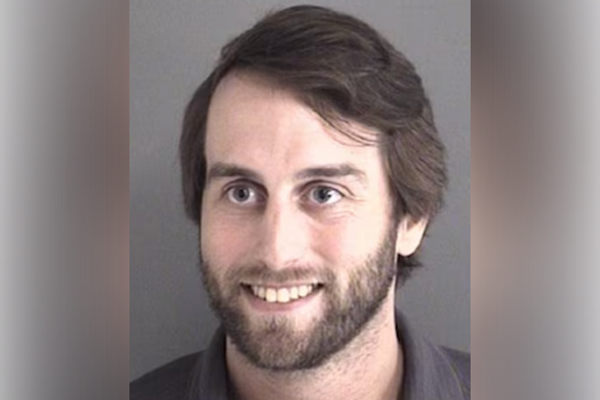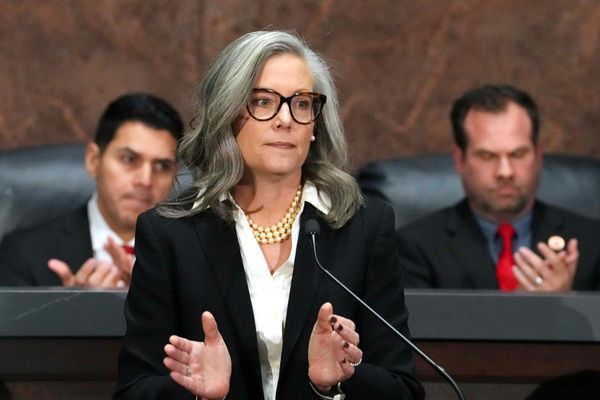
A young girl kneels on her bedroom floor, hands pressed together, as another figure towers over her, one arm raised. This watercolour, made by Eric Gill, is titled Annunciation – but for the abuse survivors currently working on a show of his work that will open in the town where he lived, this scene is far from holy. For them, it is loaded with disturbing overtones.
“What I see isn’t the Virgin Mary and the Angel Gabriel. It’s a scared little girl in a room where she ought to feel safe, with a terrifying figure looming over her, blocking the exit,” says Vivien Almond, one of the survivors involved in the project. “There’s no way out – even the window behind her is tiny.” The image, says Almond, is “all about power – the power that figure has over that young girl invading her space, threatening her. And that’s what Eric Gill was all about.”
Almond knows what she’s talking about: as a child, she was sexually abused by her own father over many years, just as Gill’s two elder daughters Betty and Petra were – a fact that didn’t come to light until a biography by Fiona MacCarthy was published in 1989, the author having found evidence of the crimes in Gill’s own previously unseen diaries.
Since then the world has grappled with how to treat the artist’s work. Some galleries have quietly removed it from view. Last week, one of his most famous pieces, a sculpture of Prospero and Ariel from Shakespeare’s The Tempest, was returned to public view at BBC Broadcasting House in London, albeit behind a protective screen, following an incident in which it was damaged. A QR code nearby now links to details of Gill’s crimes.
The BBC said it had taken “expert advice”, although it isn’t clear if that was from survivors. This new show is believed to be the first time survivors of abuse have been directly involved in deciding whether and what to show of Gill’s work and how to interpret it. It is being put together at Ditchling Museum of Art + Craft, the institution most strongly associated with his story. The museum is in the Sussex village that was home for six years to Gill and the artistic community he founded, which continued to be based there after he and his family moved to Wales in the 1920s.
Since Gill’s crimes became known, the museum, says its director Steph Fuller, has never sought to hide from the reprehensible elements of his story. A statement on its website condemns his abuse, but adds that his “importance to art and design history in the UK and across the world is impossible to ignore”.
Yet Fuller thinks more needs to be said. “I’ve felt for a while,” she says, “that the voices missing in our interpretation are the voices of the daughters who were subjected to the abuse.” Those daughters are now dead, but one day two years ago, Fuller found herself talking to Ann Sumner, chair of the Methodist Modern Art Collection (MMAC) in London. Sumner was wondering what to do with a Gill painting owned by the MMAC. From that conversation grew the idea of a new exhibition, which will lead in time to a re-imagining of the Ditchling collection overall, curated with four abuse survivors, members of the Methodist Survivors Advisory Group.
One thing the survivors were clear about, says Fuller, was the importance of showing Gill’s work and not sweeping it under the carpet. “They said hiding things and not talking about them is the culture in which abuse flourishes. There are lots of very difficult and emotive issues to discuss here. But if the survivors can do it, then the rest of us certainly can.”
Almond adds: “If you don’t show his work, you’re not telling the story of this man. My view is it needs to be seen, but included alongside it needs to be the story of what this man did, how he abused his daughters. It’s been said what he did didn’t affect these women much. But that’s rubbish. If you suffer abuse, it stays with you, it’s a pain you never get rid of, and it changes everything else that happens to you.”
The new display will be part of an exhibition at Ditchling entitled It Takes a Village, to open in early July. It will include both Annunciation, the work that so struck Almond, and other pieces including Gill drawings of Betty and Petra, among them a nude of Betty when she was 16. “That was drawn at the point when the abuse was happening,” says Fuller.
Fiona, another survivor involved in the Ditchling project, says she’s been surprised by how little museums and art galleries have consulted survivors when making decisions around Gill’s work. “Art has a tendency to be self-congratulatory and pretentious. Art historians think they know things, but actually all they know about is art. They don’t know what it’s like to survive abuse.”
One issue for her is monetary value. “When someone is a name, their work is worth more. It’s to do with someone’s reputation, but it shouldn’t be only their artistic reputation – because with Gill you’ve got someone who was much revered, but we now know he was a very unpleasant character: sleazy, a paedophile. So his value should reflect that reputation as well.”
Fiona testified against her abuser, a man who lodged in her family home when she was a child, decades after his crimes took place, and he was convicted and imprisoned. “I wanted to hold him to account, and I want to hold Gill to account. He was a smug and arrogant man and in writing about his abuse in his diaries, I think perhaps he wanted it all to come out eventually – he wanted the world to see how clever he’d been, hiding it all from everyone, making people think he was so saintly.”
Now in her 70s, Fiona says the attitude to abuse has changed for survivors over the years. “It used to be hushed up, and people would say it doesn’t do any real harm. But now it’s being more talked about that view has changed – so getting more people to speak about it is the way forward.”
Childhood books made by the Gill daughters and the 1922 sculpture Divine Lovers (Icon) – showing Christ embracing a figure representing the church – will also be included in the display, which will be in a separate room at the museum. “We’re very mindful of visitors who might have been victims of abuse,” says Fuller. “There will be a notice explaining the content before people go into the room.”
Survivors’ sensitivities have tended to be more around works that home in on intimate situations in the home, rather than with pieces that are sexually explicit, says Fuller. “We’ve been talking a lot about abuse holistically, how it happens and the family dynamics around it. Also, because the survivors are from a Christian group, and Gill was a Catholic, they’ve been interested in how he depicted spiritual and divine subjects in a sexualised way.”
• It Takes a Village is at Ditchling Museum of Art + Craft, East Sussex, in July.
• In the UK, Rape Crisis offers support for rape and sexual abuse on 0808 802 9999 in England and Wales, 0808 801 0302 in Scotland, or 0800 0246 991 in Northern Ireland. In the US, Rainn offers support on 800-656-4673. In Australia, support is available at 1800Respect (1800 737 732). Other international helplines can be found at ibiblio.org/rcip/internl.html







